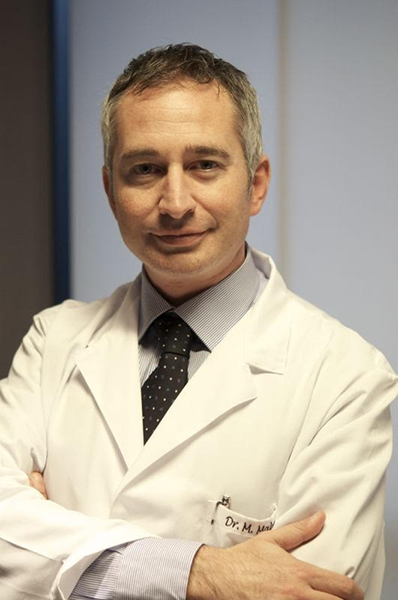Live From Italy
Involving Bowel and Cul-de-Sac
MARCH 11, 2019 (8-10AM) - LENOX HILL HOSPITAL
130 East 77th st. (Entrance near # 6 Train at 77th st & Lexington Ave.)
by Mario Malzoni, MD
Mario Malzoni is a world-renowned endometriosis specialist recognized for his extraordinary skill and multi-organ surgical work. He utilizes an innovative three-dimensional laparoscopic technique to increase surgical precision and accelerate recovery time. Dr. Malzoni serves as Director of the National Center for Endometriosis (Malzoni Group) and Chief of the Center for Advanced Pelvic Surgery. He is also Honorary-Professor Emeritus at the University and Research Centre in Moscow (RUSSIA), Scientific Director of the Malzoni Group, and past President of the Italian Society of Gynecological Endoscopy (SEGI).
PERSONAL ANAMNESIS
Menarca 13 years, regular menstruation. Not hypermenorrhea
Diagnosis of endometriosis in 2014.
Pregnancy research from 2017. Negative male factor.
BMI: 24,77 LMP: 2017
Stipsis: yes
Dysmenorrhoea (VAS 10)
Dyschezia (VAS 10)
Dyspareunia (VAS 8)
Not Dysuria Nor Haematochezia
PREVIOUS PELVIC SURGERY - LPT 2000: Appendectomy + excision of bilateral ovarian endometriomas
PREVIOUS PELVIC SURGERY – LPS 2014: excision of bilateral ovarian endometriomas
After surgery, it takes EP therapy for about 2 years, replaced with DIENOGEST for failure to control the symptoms of pain, suspended again for hypertension in 2017 (normalized after suspension).
Immediate resurgence of pain.
9/2018 INTENSE PELVIC PAIN AND HYPERPYREXIA. PID DIAGNOSIS AT FIRST AID.
PELVIC SURGERY - LPT 2018: bilateral tubovarian complex with Adesiolysis and bilateral salpingectomy.
Since the procedure under GnRH treatment (amenorrhoea).
DIAGNOSIS: Recurrence of severe pelvic endometriosis - primary infertility
US FINDINGS (TV/TA): UTERUS slightly adherent anteriorly but completely fixed posteriorly, inhomogeneous myometrial ecostructure especially posteriorly for mild diffuse adenomyosis. Endometrial rhyme of increased thickness deflected posteriorly (question mark sign).
RIGHT OVARY cranially displaced, completely adherent between the uterine fundus, pelvic wall and proximal sigma, smaller than normale due to previous surgery with reduced follicular reserve, presence of a small hypoechoic unilocular avascular pericentimetric cyst referable to a small endometrioma.
LEFT OVARY: increased dimensions due to the presence of at least 3 cysts: at the anterior pole two contiguous cysts of 22x16 and 17x13 mm referable to small pre-existing endometriomas and a hypoechoic unilocular oblong cranial cyst of 54x6x16 mm referable to further endometrioma. The normal ovarian parenchyma is limited. This ovary is completely and tenaciously adherent between the uterine body, rectum-sigma and pelvic wall. Posteriorly a dense and tenacious adhesive fibrosis possibly endometriosic or phlogistic/post-surgical, completely fixes the rectum-sigmoid intestinal mucosa at the posterior uterine wall and the ovaries.
RETROCERVICAL AREA: presence of a hypoechoic formation with non-vascularized margin of 16x7x25 mm with typical appearance for infiltrating endometriotic plaque extended to the torus, to both USL, minimally to the left lateral paracervix and discreetly to the right lateral paracervix, with an estimated distance of at least 10 mm to the left ureter and 3.5 mm to the right ureter. The right ureter appears medialized and retracted about 20 mm from the IM segment; the left ureter has a regular course but it’s completely fused in the ipsilateral periannexial fibrosis. Caudally this formation superficially infiltrates the posterior fornix. RVS is regular. Posteriorly continues with a voluminous similar formation of 63x15x19 mm with a typical appearance for an endometriotic nodule deeply infiltrating the intestinal muscular wall of the rectum/junction /distal sigma.
The morphology of this nodule is indicative of multiple segments of bowel fused as a result of the adhesion retraction and deeply infiltration, suggestive of a longitudinal extension certainly greater than measured. Estimated stenosis at the point of greatest infiltration is about 50% and similarly as the circumferential extension. The lower edge is approximately 8 cm from the anal margin.
SCHEDULED PROCEDURE: radical excision of endometriosis with segmental bowel resection with end-to-end anastomosis with suprapubic accessory minilaparotomy.








